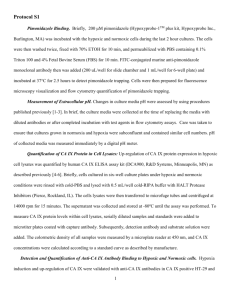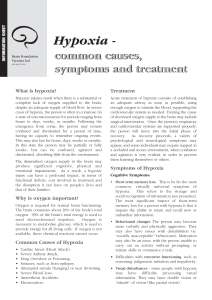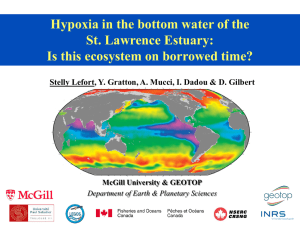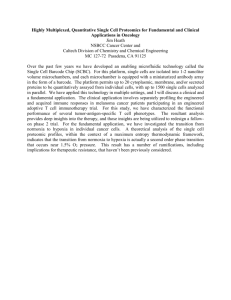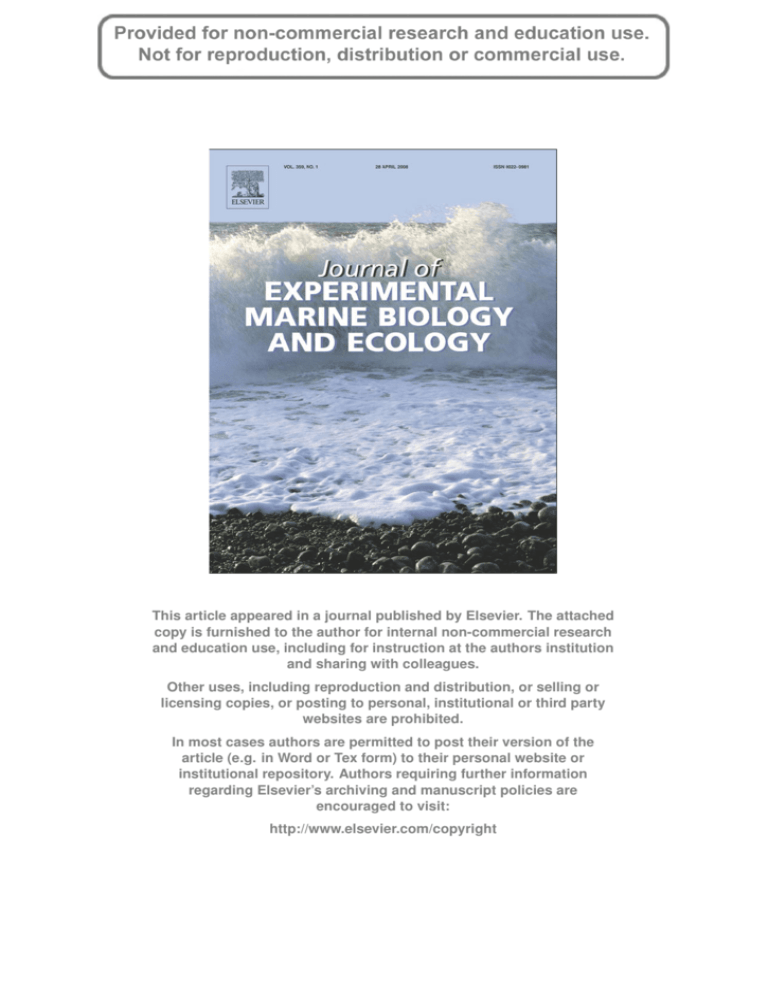
This article appeared in a journal published by Elsevier. The attached
copy is furnished to the author for internal non-commercial research
and education use, including for instruction at the authors institution
and sharing with colleagues.
Other uses, including reproduction and distribution, or selling or
licensing copies, or posting to personal, institutional or third party
websites are prohibited.
In most cases authors are permitted to post their version of the
article (e.g. in Word or Tex form) to their personal website or
institutional repository. Authors requiring further information
regarding Elsevier’s archiving and manuscript policies are
encouraged to visit:
http://www.elsevier.com/copyright
Author's personal copy
Journal of Experimental Marine Biology and Ecology 359 (2008) 34 – 39
www.elsevier.com/locate/jembe
Behavioral effects of low dissolved oxygen on the bivalve Macoma balthica
W. Christopher Long ⁎, Bryce J. Brylawski, Rochelle D. Seitz
School of Marine Science, Virginia Institute of Marine Science, The College of William and Mary, P.O. Box 1346, Gloucester Pt., VA 23062
Received 25 January 2007; received in revised form 12 September 2007; accepted 15 February 2008
Abstract
Hypoxia, a dissolved oxygen concentration (DO) below 2 mg l– 1, is a significant stressor in many estuarine ecosystems. Many sedentary
organisms, unable to move to avoid hypoxic areas, have metabolic and behavioral adaptations to hypoxic stress. We tested the effects of hypoxia on
the behavior and mortality of the clam Macoma balthica, using four levels of dissolved oxygen in flow-through tanks. We used five replicates of each
of four treatments: (1) Hypoxic (DO mean ± SE = 1.1 ± 0.06 mg O2 l– 1), (2) Moderately hypoxic (DO 2.6 ± 0.05 mg O2 l– 1), (3) Nearly normoxic
(DO 3.2 ± 0.04 mg O2 l– 1), (4) Normoxic (DO = 4.9 ± 0.13 mg O2 l– 1). We lowered the dissolved oxygen with a novel fluidized mud-bed, designed to
mimic field conditions more closely than the common practice of solely bubbling nitrogen or other gasses. This method for lowering the DO
concentrations for a laboratory setup was effective, producing 1.4 l min–1 of water with a DO of 0.8 mg O2 l– 1 throughout the experiment. The setup
greatly reduced the use of compressed nitrogen and could easily be scaled up to produce more low-DO water if necessary. The lethal concentration for
50% of the M. balthica population (LC50) was 1.7 mg O2 l– 1 for the 28-day experimental period. M. balthica decreased its burial depth under hypoxic
and moderately hypoxic (~2.5 mg O2 l– 1) conditions within 72 hours of the onset of hypoxia. By the sixth day of hypoxia the burial depth had been
reduced by 26 mm in the hypoxic tanks and 10 mm in the moderately hypoxic tanks. Because reduced burial depth makes the clams more vulnerable
to predators, these results indicate that the sub-lethal effects of hypoxia could change the rate of predation on M. balthica in the field.
© 2008 Elsevier B.V. All rights reserved.
Keywords: Behavior; Bivalves; Burial depth; Hypoxia; Eutrophication; Macoma balthica
1. Introduction
1.1. Hypoxia
Hypoxia, or dissolved oxygen concentrations (DO) below
2.0 mg l– 1, is often one of the consequences of cultural eutrophication in aquatic systems (Diaz and Rosenberg, 1995; Cloern,
2001; Gray et al., 2002; Kemp et al., 2005). It is associated with
a decrease in the density of motile animals that flee hypoxic
waters (Pihl et al., 1991; Das and Stickle, 1994; Bell and
Eggleston, 2005; Powers et al., 2005) and a decrease in the
abundance, biomass, and diversity of the sessile benthic community (Rosenberg, 1977; Gaston, 1985; Dauer et al., 1992;
Diaz et al., 1992; Llansó, 1992; Powers et al., 2005).
⁎ Corresponding author. Current address: Smithsonian Environmental
Research Center, P.O. Box 28, Edgewater, MD, 21037. Tel.: +1 443 428
2462; fax: +1 443 482 2380.
E-mail address: longw@si.edu (W.C. Long).
0022-0981/$ - see front matter © 2008 Elsevier B.V. All rights reserved.
doi:10.1016/j.jembe.2008.02.013
Benthic organisms have physiological and behavioral adaptations to hypoxia. Organisms respond by decreasing metabolism and thus oxygen consumption (Stickle et al., 1989; Wu,
2002). This, in turn, can lead to diminished growth and
reproduction (Das and Stickle, 1993; Nilsson, 1999; Condon
et al., 2001; Grove and Breitburg, 2005). Organisms change
their behavior to either increase oxygen supply or decrease
oxygen demand. For example, bivalves and polychaetes extend
siphons or palps, decrease burial depth, or even float up above
the benthic boundary layer into higher DO waters (Brafield,
1963; Rosenberg et al., 1991; Taylor and Eggleston, 2000; Seitz
et al., 2003). Some polychaetes and anemones will elongate,
increasing their surface-area-to-volume ratio to facilitate
oxygen diffusion. Organisms also lower their oxygen demand
by reducing feeding and movement (Sagasti et al., 2001).
These sub-lethal responses may have an effect on the food
web and trophic transfer if they increase an organism's vulnerability to predation. For example, the extension of siphons
and palps farther into the water column and decrease of burial
Author's personal copy
W.C. Long et al. / Journal of Experimental Marine Biology and Ecology 359 (2008) 34–39
depth make detection by predators more likely for species that
use burial depth to obtain a refuge from predation, such as the
clam, Macoma balthica (Piersma et al., 1995; De Goeij et al.,
2001). Whether predators are capable of taking advantage of
these stressed prey is a matter of debate, as predators may leave
hypoxic areas (e.g., Pihl et al., 1991; Bell and Eggleston, 2005).
Predation on tethered Glycera in field experiments was DO
dependent with predation occurring at low rates under hypoxic
conditions (Nestlerode and Diaz, 1998). In laboratory experiments, hypoxia changed the predator-prey relationship, likely
due to a change in both predator and prey behavior (Breitburg
et al., 1994; Breitburg et al., 1997; Taylor and Eggleston, 2000;
Sagasti et al., 2001; Seitz et al., 2003).
1.2. Study species and objectives
M. balthica is a small, thin-shelled clam that is common in
estuarine systems on the East Coast of the U.S. north of South
Carolina. Shell lengths are typically b 40 mm. In Chesapeake Bay,
this species comprises over 85% of the infaunal biomass in many
areas in mesohaline muddy habitats, (Holland et al., 1977; Hagy,
2002). It is an important species in the food-web, as it is preyed
upon by numerous fish and crustaceans, comprising ∼50% of the
diet of the blue crab, Callinectes sapidus (Hines et al., 1990).
M. balthica is an excellent model organism for studying the
effects of hypoxia, because it is common in areas that experience
hypoxia and is easier to manipulate than other benthic species,
such as crustaceans and polychaetes. Tolerant of hypoxia, it can
survive for an average of 15 days under near anoxic (0 mg O2 l– 1)
conditions (Brafield, 1963) and extends its siphons farther into the
water column in response to hypoxia (Seitz et al., 2003). This
clam avoids predation by burying deep in the sediment, down to
35 cm (Hines and Comtois, 1985), which makes it a good organism for examining the effect of hypoxia on burial depth.
The objectives of this study were to examine the effect of low
DO on M. balthica burial depth and mortality and to test the
35
effectiveness of a novel mechanism for the supply of low-DO
water. Prior experiments on the effects of hypoxia on M. balthica
used two levels of DO, hypoxic and normoxic (e.g., Seitz et al.,
2003). We designed this experiment to determine the effects
over a range of DO concentrations observed in the field, including moderate hypoxia (2-3 mg O2 l– 1) and near normoxia
(3–4 mg O2 l– 1). We also designed a system that uses natural
sediment oxygen demand (SOD) to reduce DO and that generates a continuous supply of low-DO water, allowing test organisms to be held in a flow-through system. The goal was to
remove confounding factors of toxicity inherent in recirculating
water systems and to generate low-DO water with a chemical
composition more typical of field conditions during hypoxic
events. In most previous experiments the DO was reduced by
bubbling gases, such as nitrogen (e.g. Seitz et al. 2003), or
hydrogen sulfide (e.g., Brafield, 1963) through the water.
2. Materials and methods
2.1. Fluidized-mud reactor
To produce and distribute low-DO water for experiments, we
designed a system that minimized our reliance on nitrogen and
allowed us to conduct the experiment in a flow-through system.
DO was lowered with two large tanks connected in series that
acted as fluidized-mud reactors (described in detail below;
Fig. 1). At the bottom of each tank, we embedded a perforated
array of poly-vinyl chloride (PVC) pipe in ∼ 15 cm of crushed
oyster shell. Above this, we layered ∼ 50 cm of mud collected
from shallow coves in the York River, Chesapeake Bay,
enriched with a small quantity (approximately 50 grams) of
Osmocote slow-release fertilizer to stimulate microbial growth.
Unfiltered seawater from the York River was dispensed into the
first tank, where it was distributed by the pipe array and flowed
up through the mud, where SOD reduced the DO. The water
drained by gravity from the first reactor into a second identical
Fig. 1. Illustration of fluidized mud-bed reactor and experimental setup. Darker water indicates lower dissolved oxygen and arrows indicate direction of water flow.
Four experimental tanks are shown on the bottom level, however, multiple replicate tanks for each treatment were used, and treatments were randomly interspersed. On
the top level, the two tanks on the right are reactor tanks, and the two on the left are distribution tanks.
Author's personal copy
36
W.C. Long et al. / Journal of Experimental Marine Biology and Ecology 359 (2008) 34–39
reactor, and from there into a 400-l distribution tank covered
with a sheet of plastic to reduce air exchange. When we ran the
system at maximum flow and allowed it to come to equilibrium,
the DO in the distribution tank stabilized at ∼ 0.8 mg O2 l– 1
(measured with a DO probe, YSI Model 85, Yellow Springs
Instruments, Dayton, Ohio, USA). The flow from the reactors,
about 1.4 l min– 1, was slightly less than what was needed for
the experiment, so we supplemented it with additional unfiltered
river water (about 70% of the low DO water came from the
reactors, and the remainder was the supplement). This necessitated bubbling a small amount of nitrogen though the water
to maintain hypoxic conditions; however, the amount used
was approximately an order of magnitude less than what was
necessary in previous experiments without the addition of the
reactors. Slowly bubbled nitrogen had the added benefit of
filling the headspace and reducing the diffusion of oxygen into
the tank. The reactor could have been the only means of
lowering the DO if we had built second reactor or if we had
reduced the number of replicates. However, we did not have
adequate space for a second reactor, and we did not want to
reduce the statistical power of the study by reducing the number
of replicates. We filled second distribution tank, for normoxic
water, with unfiltered seawater and bubbled air through it.
2.2. Experimental setup
We conducted the experiment in 40-l, transparent, plastic
tanks. We filled each tank with 20 cm of mud collected from
shallow coves in the York River where Macoma balthica are
abundant. We sieved the mud through a 2-mm mesh sieve to
remove larger bivalves and other macrofauna. Twenty tanks
were randomly assigned five replicates of each of four nominal
treatments: (1) Hypoxic (DO b 2.0 mg O2 l– 1), (2) Moderately
hypoxic (DO 2.5 ± 0.5 mg O2 l– 1), (3) Nearly normoxic (DO
3.5 ±0.5 mg O2 l– 1), and (4) Normoxic (DO N 4.0 mg O2 l– 1).
We maintained DO levels by manually adjusting the relative
amounts of hypoxic and normoxic water from the distribution
tanks. Holes drilled in the lids of the tanks and sealed with corks
allowed us to monitor the DO and temperature without fully
opening the tank lids.
We collected M. balthica with shell lengths N 20 mm from
the York River via suction sampling (Eggleston et al., 1992),
transported the clams back to the lab, and allowed them to
recover for at least 24 hours in a flow-through aquarium prior to
use. We transplanted 20 healthy clams with whole shells and a
quick siphon-withdrawal reflex into each tank. We attached a
monofilament line to the center of each clam shell with
cyanoacrylate glue and ran the line through a pinhole in the lid
of the tank. We made a mark on the line with permanent ink
35 cm above the clam, and after the clams acclimated, we
estimated the relative burial depth by measuring the distance
from the top of the lid to the mark and adjusted it for the distance
from the lid to the sediment surface to calculate the absolute
depth. Due to the curvature of the lids, topology of the sediment
surface, and the fact that the clams were not always directly
under their holes, our estimate of absolute burial depth was only
precise to ± 3 cm, and we tended to overestimate. However,
because we calculated the change in burial depth as the
difference between the distance from the lid to the mark on two
different days, thus eliminating the other sources of error, it was
precise (± 2 mm). Clams acclimated in the tanks under normoxic
conditions for at least 24 hours to allow them to recover from
handling and to bury to natural burial depths. We replaced clams
that died or did not bury before the experiment. The day we
started the experimental treatment, we removed any dead or
unburied clams without replacement. Before the experiment,
four of the tanks did not receive adequate water flow and had
high clam mortalities. These were tanks at the end of the flow
lines where water-pressure was lowest, and we prevented
additional mortalities by increasing flow to the distribution
tanks; these tanks were excluded from analyses.
After the acclimation period, we adjusted the DO in each
experimental tank to its nominal treatment range. This was
achieved by increasing the flow of hypoxic water and decreasing the flow of normoxic water. The Hypoxic tanks
received only hypoxic water, the Normoxic tanks received only
normoxic water, and the Moderately hypoxic and Nearly
normoxic tanks received a mixture of hypoxic and normoxic
water. We monitored the DO and temperature in each experimental tank daily, and adjusted the flow of the hypoxic or
normoxic water at the same time if necessary to maintain the
DO within the nominal range. We monitored the burial depth of
each clam daily for the first week and, after that, every two-three
days. Dead clams were identified if they gaped and continued to
do so when handled; they were removed. We kept the DO
within the nominal experimental ranges for 28 days before
returning it to normoxia. At the end of the experiment, we
sieved mud from each tank and counted and measured the clams
that were still alive. Proportional survival was calculated for
each tank.
2.3. Data analyses
The DO measurements were analyzed with a nested Analysis
of Variance (ANOVA; tank nested within DO treatment).
The data were square-root transformed to reduce heteroscedasticity. Change in burial depth (initial burial depth minus burial
depth on each subsequent day) was analyzed for each day up
through day 10 with a nested ANOVA (tank nested within DO
treatment). Burial depth after day 10 was not analyzed, as the
number of clams remaining in the lowest DO treatments was too
low. Where there was a significant effect of treatment, a Tukey's
pair-wise multiple comparison test was performed. We plotted
survival in each tank against the average DO, and analyzed it
with a sigmoid least-squares regression and determined the
LC50 (relative to the Normoxic controls) in SigmaPlot (Version
8.02, SPSS Science, Chicago, IL; Haendel et al., 2004).
3. Results
Our setup allowed us to keep each experimental tank within
its nominal DO range. There was a significant difference
in dissolved oxygen among the treatments (nested ANOVA;
F3,656 = 799.42; p b 0.0005), and the mean for each treatment
Author's personal copy
W.C. Long et al. / Journal of Experimental Marine Biology and Ecology 359 (2008) 34–39
37
Fig. 2. Dissolved Oxygen (DO) observations for each of the four treatment levels over the course of the experiment. Nominal treatment levels were (1) Hypoxic
(DO b 2.0 mg O2 l– 1), (2) Moderately hypoxic (DO 2.5 ± 0.5 mg O2 l– 1), (3) Nearly normoxic (DO 3.5 ± 0.5 mg O2 l– 1), and (4) Normoxic (DO N 4.0 mg O2 l– 1). Points
are the mean DO ( + 1 SE) of the tanks within each treatment. The first observation and last three observations are before and after the experimental period, respectively,
when all tanks were normoxic.
fell within the nominal range and differed from the other means
(Tukey's test, p b 0.0005; Fig. 2).
Low DO conditions caused M. balthica to reduce its burial
depth. On average on day 1, the overall burial depths were
126 mm for all treatments. By day 6, average burial depth
decreased (i.e., clams moved up toward the sediment-water
interface) by approximately 26 mm in the Hypoxic treatment
(b2.0 mg O2 l– 1) and by 10 mm in the Moderately hypoxic
treatment (∼ 2.5 mg O2 l– 1), while increasing slightly (i.e., clams
Fig. 3. Mean (± 1 SE) change in burial for each DO treatment. Hypoxic
treatments were initiated on day one. Positive numbers indicate movement
towards the water-sediment interface. Asterisks indicate a significant effect of
DO treatment on burial depth. Treatments with different letters next to them
differ at the 0.05 level (Tukey's test; shown for day 10 only). Dashed line
indicates no net vertical migration.
moving away from the sediment–water interface) in the Nearly
normoxic and Normoxic treatments. There was a significant
effect of DO treatment on change in burial depth on days 4
through 10 (nested ANOVAs; p b0.05; Fig. 3), and a significant
effect of tank (nested within DO treatment) on days 2 and 4. In
both Hypoxic (DO b 2.0 mg O2 l– 1) and Moderately hypoxic
(2.5 ± 0.5 mg O2 l– 1) treatments, the burial depth decreased
beginning almost immediately (on day 2) and reached an
asymptote at around day 6. The Hypoxic and Moderately
hypoxic treatments both differed from the Normoxic treatment
(DO N 4.0 mg O2 l– 1) on days 5 through 10 (Tukey's test).
Low DO was associated with higher clam mortality after 28
days. Clam survival decreased in a non-linear fashion with
Fig. 4. Effect of DO on M. balthica survivorship. Proportional survival at the
end of the 28-day experiment is plotted against average DO for each tank. Trend
line is from best-fit equation: y ¼ 0:76
; ðR2 ¼ 0:55; p ¼ 0:0021Þ:
x 3
1þð1:71
Þ
Author's personal copy
38
W.C. Long et al. / Journal of Experimental Marine Biology and Ecology 359 (2008) 34–39
decreasing DO, and we estimated a lethal concentration for 50%
of the population (LC50) of 1.7 ± 0.5 (SE) mg O2 l– 1 for the 28day experiment (Fig. 4).
4. Discussion
Our method for lowering the DO concentrations for a laboratory setup was effective and has several benefits. As desired, it
produced a continuous supply of flowing, hypoxic water (DO
0.8 mg l– 1) for the full duration of the experiment. Although the
flow rate of 1.4 l min– 1 was lower than was needed, it could
easily be scaled up by either using larger tanks as reactors, or by
making additional reactors. The mechanism for lowering the
DO is similar to that in the field; DO concentrations are reduced
by sediment oxygen demand (SOD). In previous laboratory
experiments, the DO was reduced by displacement through
bubbling a gas or mixture of gases, usually nitrogen (e.g., de
Zwaan and Babarro, 2001) or hydrogen sulfide (Brafield, 1963),
through the water. This difference between field and laboratory
DO development in experiments using bubbling gas for
development of hypoxia may confound the results. As our
design used a flow-through system, it avoided the use of stagnant or re-circulated water (e.g., Modig and Ólafsson, 1998;
Grove and Breitburg 2005) and the resulting high abundance of
bacteria known to lower survival times in lab experiments (de
Zwaan and Babarro, 2001; de Zwaan et al., 2001). This design
was cost effective, as it substantially reduced the amount of gas
necessary for maintaining hypoxic conditions.
A 28-day LC50 for M. balthica of 1.7 mg O2 l– 1 is comparable to values presented elsewhere in the literature; Borsuk
et al. (2002) modeled the survival of M. balthica using a
compilation of literature values and estimated a 21-day LC50 of
1.5 mg O2 l– 1. Thus, M. balthica is apparently quite tolerant of
hypoxia in the lab; however, M. balthica populations suffer
heavy mortality in the field under moderate to severely hypoxic
conditions, comparable to the range used in this experiment
(e.g., Llansó, 1992; Buzzelli et al., 2002; Powers et al., 2005).
This indicates that another form of mortality is driving the
pattern observed in the field.
These results, combined with those of prior experiments,
indicate that sub-lethal exposure to hypoxic conditions may result
in increased predation risk. M. balthica responds to hypoxia by
vertically migrating upward in the sediment. Clams in both the
Hypoxic (DO b 2.0 mg O2 l– 1) and the Moderately hypoxic
(DO ∼ 2.5 mg O2 l– 1) treatments moved towards the sediment
surface by about 26 and 10 mm, respectively. Although no
vertical migration was observed in previous similar experiments
(Seitz et al., 2003), this is likely due to differences in sediment
type; Seitz et al. (2003) used sand and we used mud. M. balthica
buries deeper in mud (its preferred habitat), down to 35 cm, than
in sand, down to 20 cm (Hines and Comtois, 1985), allowing
substantial scope for change in mud. Changes in M. balthica's
burial depth of as little as 2 cm, the change observed in the
Hypoxic tanks, can decrease predator handling time by 66%
(Piersma et al., 1995). In addition, this vertical migration may be
increased in field situations by siphon cropping. M. balthica
extends its siphons into the water column in response to hypoxia
(Seitz et al., 2003), which can lead to higher rates of siphon
cropping (Peterson and Skilleter, 1994; Skilleter and Peterson,
1994) and decreased burial depth (De Goeij et al., 2001), thus,
further increasing the vulnerability of clams to predation.
The time scale of the behavioral changes in M. balthica is
much shorter than that for lethal effects. Siphon extension
occurs within a day (Seitz et al., 2003) and burial depth reduction begins within two days and decreases substantially
within four days (this study), whereas significant mortality
under moderately hypoxic conditions (1–2 mg O2 l– 1) does not
occur for one to two weeks (Borsuk et al., 2002), or longer
(Seitz et al., 2003). In many systems where hypoxia is episodic,
such as the York River (Diaz et al., 1992), the Neuse River
(Powers et al., 2005), and parts of the Baltic Sea (Modig and
Ólafsson, 1998), hypoxic conditions seldom last for more than a
week at a time before returning to normoxia. As M. balthica is
highly tolerant of episodic hypoxia (Modig and Ólafsson,
1998), we suggest that predators taking advantage of stressed
prey may be a major source of mortality in these systems.
Predator behavior in systems that suffer from hypoxia could
lead to an increase in foraging after a hypoxic episode. Motile
predators can rapidly reinvade areas after relaxation of hypoxic
conditions (e.g., Pihl et al., 1991; Nestlerode and Diaz, 1998;
Bell and Eggleston, 2005). They may take advantage of stressed
benthic organisms following hypoxia, as their diet shifts to
include a higher percentage of deeper-burying organisms, including M. balthica (Pihl et al., 1992; Long and Seitz, 2008).
These results indicate that this increase in predator foraging may
be due to the demonstrated vertical migration of M. balthica in
response to hypoxia in systems where this species is common.
Acknowledgments
We would like to thank K. Knick, J. Long, and M. Seebo for
help with the experiment. Comments by R. Diaz, J. Long, D.
Wolcott, and two anonymous reviewers substantially improved
earlier versions of this paper. C. Long was supported by an EPA
GRO fellowship. Funding for this project was provided by the
Commonwealth of Virginia. This is contribution 2915 from the
Virginia Institute of Marine Science. [RH]
References
Bell, G.W., Eggleston, D.B., 2005. Species-specific avoidance responses by
blue crabs and fish to chronic and episodic hypoxia. Mar. Biol. 146,
761–770.
Borsuk, M.E., Powers, S.P., Peterson, C.H., 2002. A survival model of the
effects of bottom-water hypoxia on the population density of an estuarine
clam (Macoma balthica). Can. J. Fish. Aquat. Sci. 59, 1266–1274.
Brafield, A.E., 1963. The effects of oxygen deficiency on the behavior of Macoma balthica (L.). Anim. Behav. XI, 2–3.
Breitburg, D.L., Steinberg, N., DuBeau, S., Cooksey, C., Houde, E.D., 1994.
Effects of low dissolved oxygen on predation on estuarine fish larvae. Mar.
Ecol. Prog. Ser. 104, 235–246.
Breitburg, D.L., Loher, T., Pacey, C.A., Gerstein, A., 1997. Varying effects of
low dissolved oxygen on trophic interactions in an estuarine food web. Ecol.
Monogr. 67, 489–507.
Buzzelli, C.P., Luettich, R.A., Powers, S.P., Peterson, C.H., McNinch, J.E.,
Pinckney, J.L., Paerl, H.W., 2002. Estimating the spatial extent of bottom-
Author's personal copy
W.C. Long et al. / Journal of Experimental Marine Biology and Ecology 359 (2008) 34–39
water hypoxia and habitat degradation in a shallow estuary. Mar. Ecol. Prog.
Ser. 230, 103–112.
Cloern, J.E., 2001. Our evolving conceptual model of the coastal eutrophication
problem. Mar. Eco., Prog. Ser. 210, 223–253.
Condon, R.H., Decker, M.B., Purcell, J.E., 2001. Effects of low dissolved
oxygen on survival and asexual reproduction of scyphozoan polyps
(Chrysaora quinquecerrha). Hydrobiologia 451, 89–95.
Das, T., Stickle, W.B., 1993. Sensitivity of crabs Callinectes sapidus and C.
similis and the gastropod Stramonita haemastoma to hypoxia and anoxia.
Mar. Ecol. Prog. Ser. 98, 263–274.
Das, T., Stickle, W.B., 1994. Detection and avoidance of hypoxic water by
juvenile Callinectes sapidus and C. similis. Mar. Biol. 120, 593–600.
Dauer, D.M., Rodi Jr., A.J., Ranasinghe, J.A., 1992. Effects of low dissolved
oxygen events on the macrobenthos of the lower Chesapeake Bay. Estuaries
15, 348–391.
De Goeij, P., Luttikhuizen, P.C., van der Meer, J., Piersma, T., 2001. Facilitation
on an intertidal mudflat: the effect of siphon nipping by flatfish on burying
depth of the bivalve Macoma balthica. Oecologia 126, 400–506.
de Zwaan, A., Babarro, J.M.F., 2001. Studies on the causes of mortality of the
estuarine bivalve Macoma balthica under conditions of (near) anoxia. Mar.
Biol. 138, 1021–1028.
de Zwaan, A., Schaub, B.E.M., Bararro, J.M.F., 2001. Anoxic survival of Macoma balthica: the effect of antibiotics, molybdate and sulphide. J. Exp. Mar.
Biol. Ecol. 256, 241–251.
Diaz, R.J., Rosenberg, R., 1995. Marine benthic hypoxia: A review of its
ecological effects and the behavioral responses of benthic macrofauna.
Oceanogr. Mar. Biol. Ann. Rev. 33, 245–303.
Diaz, R.J., Neubauer, R.J., Schaffner, L.C., Pihl, L., Baden, S.P., 1992.
Continuous monitoring of dissolved oxygen in an estuary experiencing
periodic hypoxia and the effect of hypoxia on macrobenthos and fish. Sci.
Total Environ. 1055–1068 (Suppl. 1992).
Eggleston, D.B., Lipcius, R.N., Hines, A.H., 1992. Density-dependent predation
by blue crabs upon infaunal clam species with contrasting distribution and
abundance patterns. Mar. Ecol. Prog. Ser. 85, 55–68.
Gaston, G.R., 1985. Effects of hypoxia on macrobenthos of the inner shelf off
Cameron, Louisiana. Est. Coast. Shelf Sci. 20, 603–613.
Gray, J.S., Wu, R.S., Or, Y.Y., 2002. Effects of hypoxia and organic enrichment
on the coastal marine environment. Mar. Ecol. Prog. Ser. 238, 249–279.
Grove, M., Breitburg, D.L., 2005. Growth and reproduction of gelatinous
zooplankton exposed to low dissolved oxygen. Mar. Ecol. Prog. Ser. 301,
185–198.
Haendel, M.A., Tilton, F., Bailey, G.S., Tanguary, R.L., 2004. Developmental
toxicity of the dithiocarbamate pesticide sodium matam in zebrafish. Toxicol.
Sci. 81, 390–400.
Hagy, J.D., 2002. Eutrophication, hypoxia, and trophic tranfer efficiency in
Chesapeake Bay. PhD dissertation, University of Maryland, Center for
Environmental Science, Solomons, Maryland. USA.
Hines, A.H., Comtois, K.L., 1985. Vertical distribution of infauna in sediments
of a subestuary of central Chesapeake Bay. Estuaries 8, 296–304.
Hines, A.H., Haddon, A.M., Wiechert, L.A., 1990. Guild structure and foraging
impact of blue crabs and epibenthic fish in a subestuary of Chesapeake Bay.
Mar. Ecol. Prog. Ser. 67, 105–126.
Holland, A.F., Mountford, N.K., Mihursky, J., 1977. Temporal variation in
upper bay and mesohaline communities: I. The 9-m mud habitat. Chesap.
Sci. 18, 370–378.
Kemp, W.M., Boynton, W.R., Adolf, J.E., Boesch, D.F., Boicourt, W.C., Brush,
G., Cornwell, J.C., Fisher, T.R., Glibert, P.M., Hagy, J.D., Harding, L.W.,
39
Houde, E.D., Kimmel, D.G., Miller, W.D., Newell, R.I.E., Roman, M.R.,
Smith, E.M., Stevenson, J.C., 2005. Eutrophication of Chesapeake Bay:
historical trends and ecological interactions. Mar. Ecol. Prog. Ser. 303, 1–29.
Llansó, R.J., 1992. Effects of hypoxia on estuarine benthos: The lower
Rappahannock River (Chesapeake Bay), a Case Study. Est. Coast. Shelf Sci.
359, 491–515.
Long, W.C., Seitz, R.D., 2008. Trophic interactions under stress: hypoxia
enhances foraging in an estuarine food web. Mar. Ecol. Prog. Ser.
doi:10.3354/meps07395.
Modig, H., Ólafsson, E., 1998. Responses of Baltic benthic invertebrates to
hypoxic events. J. Exp. Mar. Biol. Ecol. 229, 133–148.
Nestlerode, J.A., Diaz, R.J., 1998. Effects of periodic environmental hypoxia on
predation of a tethered polychaete, Glycera americana: implications for
trophic dynamics. Mar. Ecol. Prog. Ser. 172, 185–195.
Nilsson, H.C., 1999. Effects of hypoxia and organic enrichment on growth of the
brittle stars Amphiura filiformis (O.F. Muller) and Amphiura chiajei Forbes.
J. Exp. Mar. Biol. Ecol. 237, 11–30.
Peterson, C.H., Skilleter, G.A., 1994. Control of foraging behavior of
individuals within an ecosystem context: the clam Macoma balthica, flow
environment, and siphon-cropping fishes. Oecologia 100, 256–267.
Piersma, T., Van Gils, J., de Goeij, P., van der Meer, J., 1995. Holling's
functional response model as a tool to link the food-finding mechanism of a
probing shorebird with its spatial distribution. J. Anim. Ecol. 64, 493–504.
Pihl, L., Baden, S.P., Diaz, R.J., 1991. Effects of periodic hypoxia on
distribution of demersal fish and crustaceans. Mar. Biol. 108, 349–360.
Pihl, L., Baden, S.P., Diaz, R.J., Schaffner, L.C., 1992. Hypoxia-induced
structural changes in the diet of bottom feeding fish and crustacea. Mar. Biol.
112, 349–361.
Powers, S.P., Peterson, C.H., Christian, R.R., Sullivan, E., Powers, M.J., Bishop,
M.J., Buzzelli, C.P., 2005. Effects of eutrophication on bottom habitat and
prey resources of demersal fishes. Mar. Ecol. Prog. Ser. 302, 233–243.
Rosenberg, R., 1977. Benthic macrofaunal dynamics, production, and
dispersion in an oxygen-deficient estuary of west Sweden. J. Exp. Mar.
Biol. Ecol. 26, 107–133.
Rosenberg, R., Hellman, B., Johansson, B., 1991. Hypoxic tolerance of marine
benthic fauna. Mar. Ecol. Prog. Ser. 79, 127–131.
Sagasti, A., Schaffner, L.C., Duffy, J.E., 2001. Effects of periodic hypoxia on
mortality, feeding and predation in an estuarine epifaunal community.
J. Exp. Mar. Biol. Ecol. 258, 257–283.
Seitz, R.D., Marshall, L.S., Hines, A.H., Clark, K.L., 2003. Effects of hypoxia on
predator-prey dynamics of the blue crab (Callinectes sapidus) and the Baltic clam
(Macoma balthica) in Chesapeake Bay. Mar. Ecol. Prog. Ser. 257, 179–188.
Skilleter, G.A., Peterson, C.H., 1994. Control of foraging behavior of
individuals within an ecosystem context: the clam Macoma balthica and
interactions between competition and siphon cropping. Oecologia 100,
258–278.
Stickle, W.B., Kapper, M.A., Liu, L.L., Gnaiger, E., Wang, S.Y., 1989.
Metabolic adaptations of several species of crustaceans and mollusks to
hypoxia: tolerance and microcalorimetric studies. Biol. Bull. 177, 303–312.
Taylor, D.L., Eggleston, D.B., 2000. Effects of hypoxia on an estuarine predatorprey interaction: foraging behavior and mutual interference in the blue crab,
Callinectes sapidus, and the infaunal clam prey, Mya arenaria. Mar. Ecol.
Prog. Ser. 196, 221–237.
Wu, S.S.R., 2002. Hypoxia: from molecular responses to ecosystem responses.
Mar. Pollut. Bull. 45, 35–45.



